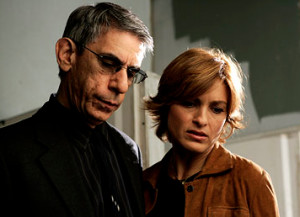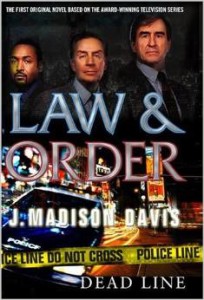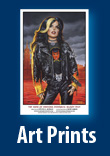 Welcome to part two of Law & Order: Tales of Development Hell, part of a series of posts in which I tell you about projects I was hired to work on that never made it all the way to completion. As you might have guessed—if you haven’t read part one, from September 13 (which was the 25th anniversary of L&O’s debut)—this particular tale has to do with my involvement as an editor for ibooks, inc. in a Law & Order publishing program that never really got off the ground. When I left off, the novel pitches that we’d submitted to Wolf Films had been accepted, and the authors we’d selected to kick off the program had started writing their manuscripts. But then we ran into a couple of problems.
Welcome to part two of Law & Order: Tales of Development Hell, part of a series of posts in which I tell you about projects I was hired to work on that never made it all the way to completion. As you might have guessed—if you haven’t read part one, from September 13 (which was the 25th anniversary of L&O’s debut)—this particular tale has to do with my involvement as an editor for ibooks, inc. in a Law & Order publishing program that never really got off the ground. When I left off, the novel pitches that we’d submitted to Wolf Films had been accepted, and the authors we’d selected to kick off the program had started writing their manuscripts. But then we ran into a couple of problems.
Problem 1: Law & Order was a Wolf Films, not an NBC, production, and unlike NBC, at the time Wolf Films didn’t have a licensing division dedicated to expanding the L&O brand into other areas. The solution presented was for a representative of the show’s writing staff to be my contact—as well as be the person who’d have approval over the manuscripts.
Problem 2: Since neither of the authors lived in New York, I needed to provide them with reference material for both the city and the shows. Taking shots of NYC and guiding the authors to make the city a character in its own right wasn’t a challenge, but with regard to show reference, I could think of only one solution: photographs of the sets.
Except there were none, I was told. The company used photographers for taking production shots while they were filming, but there were no shots of the empty sets. And when I suggested that they give me access so I could take reference photos, I was told that couldn’t happen, either. They’d be happy to give me a tour of the sets, but I couldn’t take any pictures.
Well, that was a complication. I pointed out that, just the other week, the magazine Entertainment Weekly had run an article on NYPD Blue—an article about the sets, complete with numerous photographs. It’s not like L&O’s sets were a state secret. True, but the policy wasn’t going to change. Did I still want to come over? The cast and crew would be off filming the next day, so the sets would be deserted.
Sure. A once-in-a-lifetime chance, I figured. So I hopped a cross-town bus and went over to Chelsea Piers on Manhattan’s West Side, where the sets were located, and was greeted by one of their production people—a genial guy who later went on to a novel-writing career. He gave me the nickel tour: the 27th Precinct’s detectives’ squad room, the DA’s offices, the lone courtroom (constantly being redressed for use as multiple courts), the Riker’s Island interview room, even the medical examiner’s autopsy room (next door to the courtroom). It was great to see all this stuff; too bad I couldn’t share what I was seeing with anyone.
(Side note: I couldn’t record any details of the sets, but thanks to the Internet, in this 2004 tour video hosted by L&O star Jerry Orbach, you can pretty much see what I saw.)
When the manuscripts arrived, it was time for me to get to work. Unfortunately, it became apparent as I was editing the SVU novel that the author wasn’t as familiar with the cast (like me, she was more of an original L&O fan), or with New York City in general, in terms of locations and in presenting the city as its own “character.” She and I tried to work around the complications, but eventually we both agreed that the manuscript wasn’t right and we took it off the publishing list. Hey, it happens—a talented writer and an intellectual property don’t always match up.
So that left me with the L&O novel, and that author—a former prosecutor who not only knew the justice system, but was a major L&O fan and an acclaimed mystery writer—nailed it. At least, he did as far as I was concerned. My contact thought differently, after he’d read the edited manuscript, and…well, you can see where this is going, right?
Yup, three drafts and numerous revisions later—including one in which I had to basically tear apart the manuscript and rebuild it to accommodate demands that the novel be broken into law in the first half, order in the second half, just like the show (even though the show’s staff writers occasionally broke that rule themselves)—the book got rejected and canceled. I handed the manuscript back to the author and told him he was free and clear to turn the story into a non-L&O mystery novel, if he ever felt the desire (which he did, a few years later). Then I informed ibooks, inc. publisher Byron Preiss that I was done working on the license—dealing with the writing contact was just too frustrating.
 Eventually, one novel finally made it to bookstores, under another ibooks editor: 2004’s Law & Order: Dead Line, by J. Madison Davis, currently the North American president of the International Association of Crime Writers. To date, it remains the only L&O novel ever produced. Unfortunately, it was released solely in mass-market paperback form—despite my insistence that whenever a first L&O novel eventually got published it should be a hardcover “event” (also because hardcovers and trade paperbacks have longer shelf lives in bookstores), ibooks, inc. went with the cheaper version that was quickly forgotten. You can buy used copies from online retailers like Amazon, if you want to check it out; it got some good reviews.
Eventually, one novel finally made it to bookstores, under another ibooks editor: 2004’s Law & Order: Dead Line, by J. Madison Davis, currently the North American president of the International Association of Crime Writers. To date, it remains the only L&O novel ever produced. Unfortunately, it was released solely in mass-market paperback form—despite my insistence that whenever a first L&O novel eventually got published it should be a hardcover “event” (also because hardcovers and trade paperbacks have longer shelf lives in bookstores), ibooks, inc. went with the cheaper version that was quickly forgotten. You can buy used copies from online retailers like Amazon, if you want to check it out; it got some good reviews.
But, oh, what could have been…
Interested in previous installments of Tales of Development Hell? Then check out the stories behind these could-have-been projects:
Battlestar Galactica: The New Young Warriors
“Horror Express” Movie Review: Part 1, Part 2
Speed Racer: Leviathan: Part 1, Part 2, Part 3
Spider-Man/Gambit
Teenage Mutant Ninja Turtles: The Jewels of Ishlanon
Coming tomorrow: Yet another tale, this one marking the 20th anniversary of the movie Se7en—and the sequel novel I came close to writing!






